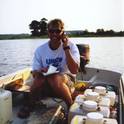Understanding ocean acidification is important because the global increase in carbon dioxide can cause seawater to become undersaturated with respect to calcium carbonate bio-minerals (e.g., aragonite and calcite) that shelled organisms need to live. Community respiration at depth in marine environments, which produces carbon dioxide, causes deeper waters to be typically more corrosive than surface waters. Coastal upwelling areas, such as the coastal Pacific Ocean that feeds the Salish Sea, can be intermittently exposed to corrosive water conditions. Ocean acidification has increased the frequency, intensity, and duration of corrosive conditions off the Oregon shelf (Harris et al., 2013) and has been observed to be detectable in Puget Sound (Feely et al., 2010). We investigated the spatial and temporal expression at two stations in the central portion of the Salish Sea: one in San Juan Channel and one in the Strait of Juan de Fuca. We sampled seawater semi-weekly at four depths primarily during fall during 2011 and 2012, measuring temperature, salinity, oxygen, nutrients, dissolved inorganic carbon, and total alkalinity. Seawater density, pCO2, pH, and aragonite saturation were derived from these variables. Carbon system variables showed variable distribution patterns with depth, location, over season, and interannually. Variation in pH and pCO2 primarily matched that of the hydrography, indicating the strong role of mixing in San Juan Channel and of stratification between estuarine (shallow outflowing) and oceanic (deep inflowing) waters in the Strait of Juan de Fuca. Also, a seasonal pattern was indicated, with evidence of upwelling and inflow of ocean-sourced waters with lower pH, higher pCO2, and lower aragonite saturation state in the fall. These waters, with more extreme values at depth in the Strait, were also evident at depth in the Channel. After this observation, subsequent weeks showed little variation over depth; however, the mean pH had shifted to lower values throughout the water column at both sites, consistent with mixing. These data can be interpreted to imply that deep oceanic intrusions of corrosive waters coming into the Salish Sea through the Strait of Juan de Fuca are mixed throughout the water column in locations like the San Juan Channel, where topographic features like sills and reefs, as well as strong tidal forcing, cause strong mixing. This effect, while decreasing the intensity of the corrosive signal at depth, can increase the spatial footprint of undersaturated waters to surface layers. Moreover, sills, which are common in the Salish Sea, can increase the residence time of these waters due to “re-fluxing” (Ebbesmeyer, 1980), meaning that mixing over sills retains some of the waters that would have been exported in the outflowing water through estuarine circulation.
Available at: http://works.bepress.com/jude_apple/9/
